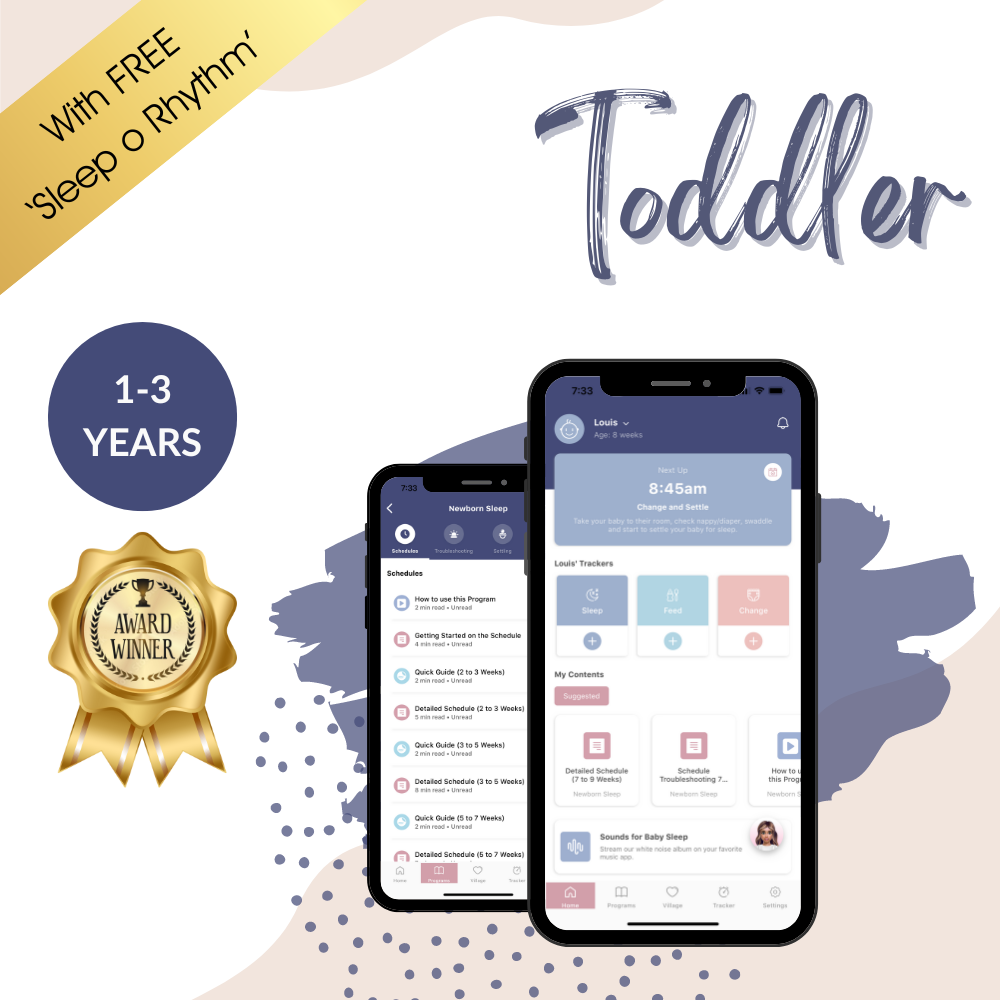
How to stop co-sleeping: a step by step guide
We’ve all been there… your baby or toddler has woken for what feels like the millionth time that night and you are just too exhausted to try to settle them back to sleep in their bed, so you bring them into bed with you. You think it’s just going to be for one night, but then that one night turns into one week, then into one month, and then suddenly you can’t remember the last time you had your bed to yourself!
If this sounds familiar and you are wanting to find out how to stop co-sleeping, we can help.
In this article:
- What is co-sleeping?
- Why do parents co-sleep with their baby or toddler?
- Why might parents want to stop co-sleeping?
- When is the best time to stop co-sleeping?
- How to stop co-sleeping
You CAN have a better night’s sleep!
Whatever your current sleep situation, we've got the tools, the information and the personalised support to help you and your little one reclaim those nights.
Get our Sleep Programs
What is co-sleeping?
The term co-sleeping comes up a lot in parenting groups, blogs and websites but can actually mean different things. In some cases, co-sleeping simply refers to sharing a room with your baby or toddler - where they have their own sleeping space separate to yours. In most instances though, co-sleeping refers to sharing a bed with your baby or toddler, which will be the focus of this article.
Why do parents co-sleep with their baby or toddler?
For some parents, co-sleeping is a choice that they have actively made - it’s something they enjoy and want to continue doing with their baby or toddler. For a lot of parents though, co-sleeping is not something they set out to do but more of a last resort when sleep deprivation kicks in. In fact, over 60% of mothers will end up bed-sharing in some capacity to try to get more sleep (1).
Why might parents want to stop co-sleeping?
Initially, co-sleeping can seem like a good “fix” for dealing with overnight wakes. Being close to your baby or toddler can sometimes help them to fall asleep for longer stretches. Or if they are waking quite frequently overnight, co-sleeping means you can quickly feed or settle them, helping your baby to fall asleep again without even getting out of bed.
Unfortunately, in most cases, co-sleeping is not sustainable long-term and can actually mean you and your baby get less sleep overnight. It’s also important to note that safe sleep guidelines advise against bed-sharing, especially in the first 12 months, because this can increase the risk of sudden unexpected infant death, including SIDS (2).
Some reasons why you might want to stop co-sleeping include:
- You are concerned for your baby’s safety and would prefer them to have their own sleep space.
- You are not getting enough restorative sleep overnight - either because you cannot relax with your baby next to you or because your baby is waking or moving too much.
- Your baby has started to wake in between sleep cycles overnight and co-sleeping is not helping them to sleep for longer stretches.
- Co-sleeping with your baby or toddler is putting a strain on your relationship with your partner.
When is the best time to stop co-sleeping?
Safe sleep guidelines recommend that babies sleep in the parents’ room, but on a separate surface designed for infants, for the first 6-12 months (2). If you are co-sleeping with a baby who is under 12 months, we would recommend getting them sleeping in their own bed again as soon as possible.
Over 12 months, the risk of SIDs - sudden unexplained infant death, decreases, so there is less urgency in stopping co-sleeping. If you enjoy co-sleeping with your toddler and you are both getting a restful night’s sleep then you can make the transition whenever you feel ready. It’s important to note though that sleep associations grow stronger over time so the longer you co-sleep, your baby or toddler will get used to sleeping in your room and the harder it will be to move your toddler to their own bed. If you know that co-sleeping is not your long-term plan, it would be best to tackle this transition sooner rather than later!
I want to stop co-sleeping now, where do I start?
Most parents resort to co-sleeping with their baby or toddler because they are waking frequently overnight so the first step is making sure everything is lined up to give them the best chance at settling and sleeping well in their own bed overnight.
1. Start by setting up a positive sleep environment.
- For babies and toddlers under 2 years, we recommend sleeping in a dark room without any nightlights or mobiles to distract them.
- Playing continuous white noise during naps and overnight sleep can also help with settling and linking sleep cycles.
- For babies who aren’t rolling yet, it’s important to have them swaddled to suppress their startle reflex.
- For older babies and toddlers, we recommend a baby sleeping bag or sleep sack to help keep them warm overnight.
- A cuddly or comforter can also be a helpful settling tool for older babies and toddlers.
2. Next, make sure they are perfectly ready for sleep! Babies and toddlers require a delicate balance of awake time and sleep during the day in order to sleep well overnight. Our Little Ones App can help with making sure nap times are spot on for your baby’s age, which prevents both over and undertiredness - two of the main reasons why a baby will be hard to settle or sleep well in their own bed
3. Lastly, establish a relaxing bedtime routine that you will use before naps and overnight sleep. Babies and toddlers thrive on predictability, so having a consistent bedtime routine is an effective way to signal to them that it’s time for sleep. This bedtime routine can be as simple as having a cuddle and saying a sleep phrase such as “time for bed now” or it can include other activities like reading a book or singing a lullaby.
Say goodbye to sleepless nights.
Join over 800,000 families worldwide who are enjoying excellent sleep with our Sleep Programs, created by experts in the field of pediatric sleep.
Get our Sleep Programs
How to stop co-sleeping for babies under 6 months
Safe sleep guidelines recommend sharing a room with your baby for the first 6 months so if you have been bed-sharing with your baby, start by establishing their own sleeping space (such as a bassinet, cot or crib) in your bedroom.
At both naps and overnight wakes, settle your baby all the way to sleep with either feeding or rocking, then hold them in your arms for 10-15 mins until they enter a deep sleep. Lower them feet-first into their bed and if needed, continue to gently rock or pat them in their bed until they fall asleep. Repeat this process each time they wake overnight.
If your baby is between 3-6 months and is waking roughly every 2hrs overnight, they may have hit the 4 Month Regression. In this case, working on self-settling is going to be the key to improving both their naps and overnight sleep. Focus on the start of naps and bedtime to begin with and this will give your baby the best chance at resettling themselves when they wake in between sleep cycles overnight. Our Little Ones App contains several gentle methods to choose from if you are wanting to guide your baby towards self-settling now.
How to stop co-sleeping for babies between 6-12 months
At this age, your baby will have become more reliant on your presence in order to settle to sleep so working on self-settling is going to be the key to helping them sleep for longer stretches overnight.
We recommend working through the following steps to move away from co-sleeping and guide your baby towards self-settling.
1.Teach your baby to sleep in their own bed for naps and at night-time (while their bed is in your room).
Settle your baby all the way to sleep with either feeding or rocking, then transfer them to their bed. Repeat this process each time they wake overnight. The most important thing at this point is that your baby is learning to fall asleep in their own bed. They are learning that this is the space where they sleep, rather than on you or in your bed.
2. Teach your baby to self-settle at the start of all naps and bedtime while still in your room.
Our Little Ones App contains several gentle self-settling sleep methods to choose from but you can also try gradually reducing your settling input before naps and bedtime. So feed or rock your baby until drowsy rather than all the way to sleep, then give them a chance to settle themselves the rest of the way. If your baby gets upset, feed or rock to soothe them until they are calm and then give them another chance to self-settle to sleep. If your baby wakes overnight, continue to feed or rock them to sleep for now.
At this stage, if your baby is sleeping well overnight and you want to continue room-sharing, you can. If your baby is still waking quite frequently overnight though, it may be time to move them to their own room now to give them a better chance at resettling themselves when they wake overnight.
3. Move your baby to her own room now - you can camp in with them for a few nights if you like to reassure them.
Try to keep the sleep environment as similar as possible and if your baby uses a pacifier or cuddly/comforter, make sure they have those with them too. This stage is just focused on getting your baby used to sleeping in the new environment so while you are camping in their room, continue to feed or rock them back to sleep when they wake overnight.
4. Move out of your baby’s room and teach them to self-settle in the night.
When your baby wakes, give them some time to resettle themselves as long as they are happy in their bed. If they start to get upset, then go in to offer a feed if needed, then help them to resettle back to sleep by following the same process that you used at the start of naps and bedtime. Until a baby is established on solids, 1-2 wakes overnight for feeds is considered quite normal but if your baby is waking more frequently than that, it may mean that they are under or overtired or have developed habit wakes overnight.
How to stop co-sleeping for toddlers between 12 months—2 years
If you have an older toddler who is used to being fed or rocked to sleep, you can follow the steps above to guide them towards self-settling and sleeping in their own bed now. If you are no longer able to feed or rock them to sleep though, you can use your presence, touch and voice to settle them to sleep in their bed instead:
- Set up a chair next to their bed and try using touch and voice to settle them to sleep in their bed at the start of naps and bedtime. If they start to get distressed, pick them up and cuddle to soothe them until they are calm, then put them back in bed and repeat the process.
- Once you are able to settle them to sleep in their bed using touch and voice, you can start to work towards self-settling by gradually reducing your input or by following one of the self-settling methods in our Little Ones App.
- Once your toddler is able to self-settle without you in the room at the start of naps and bedtime, you can then move them into their own room and start to work on self-settling at their overnight wakes if needed.
How to stop co-sleeping for toddlers over 2 years
Toddlers this age understand a lot more about what’s going on in the world around them so communication is key! You want to reassure them that the transition to their own crib/bed or own room is a time to be excited rather than scared. It’s best to start this transition at a time when there are no other major changes in your toddler’s life such as moving house, going away on holidays, starting daycare or a new baby joining the family.
Let's get your little one's sleep sorted ASAP!Our award-winning Sleep Programs will solve your baby's sleep challenges in no time.
Get our Sleep Programs
Try to involve them in the process as much as possible by letting them pick out new crib/bed sheets or a cuddly/comforter if they don’t have one already. You may also want to introduce a nightlight now to help reassure them when they are going to bed or wake overnight.
The 2 Year Regression can be a particularly difficult time when it comes to separation anxiety, nap refusal and overnight waking and it’s very easy for new sleep associations to form during this time. Even just a few nights of resorting to co-sleeping again can set you right back so consistency is important.
If your toddler is struggling with separation anxiety, you may need to take a more gradual approach to self-settling - sitting next to their bed initially and then moving further away every few days until you are out of the room.
It can be quite tempting to move your toddler to a bed now but we recommend holding off on this for as long as possible. Once in a bed, the novelty of being able to get out on their own can mean your toddler wakes a lot more than when they were in a crib or cot. If you have already made the transition to a bed now, then silently return your toddler to bed each time they get out. What you are teaching them is that their behaviour is not being rewarded by a response from you.
Conclusion
There are lots of reasons why a parent might want to stop co-sleeping but more often than not, it’s because co-sleeping is no longer working for them or their baby.
In order to stop co-sleeping with your baby or toddler, you want to make sure everything is lined up to give them the best chance at settling and sleeping well in their own bed. This includes setting up a positive sleep environment and making sure nap times are appropriate for their age. For older babies or toddlers, it also means teaching them to self-settle so that they are then able to resettle themselves when they wake overnight.
Our Little Ones App helps to take out all the guesswork out of nap times and offers several gentle self-settling methods to choose from, including a dedicated Co-Sleeping Method for babies over 6 months. When you purchase our Complete Sleep Program, you'll also get ongoing access to the Little Ones Village where our Certified Sleep Consultants can support you throughout this transition.
------------
Bibliography
https://pediatrics.aappublications.org/content/138/5/e20162938
https://raisingchildren.net.au/newborns/sleep/where-your-baby-sleeps/co- sleeping
https://www.whattoexpect.com/first-year/cosleeping.aspx#stop
https://www.todaysparent.com/family/family-health/how-to-stop-co-sleeping-an-age-by-age-guide/

Receive product and services updates, promotional offers and other marketing communications based.





